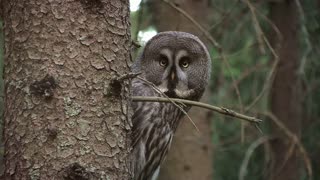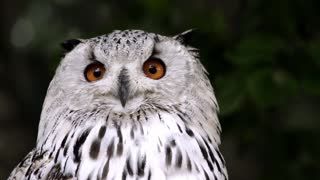Owls - A Fascinating bird - Interesting Science Facts
Owls are indeed captivating creatures that boast a myriad of fascinating features. These nocturnal birds of prey, characterized by their large, round eyes and silent flight, have captivated human imaginations for centuries. Here are some intriguing science facts that make owls truly remarkable:
1. **Adaptations for Night**: Owls are well-equipped for night hunting. Their oversized eyes are adapted for low-light conditions, allowing them to see exceptionally well in the dark. Additionally, specialized feathers enable nearly silent flight, enabling them to surprise their prey with stealth.
2. **Exceptional Hearing**: Owls have exceptional hearing abilities. Their facial discs funnel sound to their ears, and the asymmetrical positioning of their ears allows them to pinpoint the source of a sound accurately. This auditory precision helps them locate prey even in complete darkness.
3. **Diverse Species**: There are around 200 different species of owls across the globe, each with its unique characteristics and adaptations. From the tiny Elf Owl to the imposing Snowy Owl, these birds display a wide range of sizes, colors, and behaviors.
4. **Predatory Prowess**: Owls are skilled predators, primarily feeding on small mammals, birds, and insects. Their strong talons and hooked beaks make them efficient hunters. Some owl species are known for their ability to capture prey larger than themselves.
5. **Silent Hunters**: Owls possess specialized wing feathers that reduce turbulence and noise during flight. This silent flight adaptation allows them to approach prey without detection, giving them a significant advantage in hunting.
6. **Regurgitation and Pellets**: Owls cannot digest the bones, fur, and feathers of their prey. Instead, they regurgitate these indigestible parts as compact pellets. Scientists often dissect these pellets to study the owl's diet and the ecosystem it inhabits.
7. **Global Distribution**: Owls can be found on every continent except Antarctica. They have adapted to a wide range of habitats, from dense forests to deserts and grasslands.
8. **Mysterious Symbolism**: Owls have held symbolic significance in various cultures throughout history. They are often associated with wisdom, mystery, and protection. In Greek mythology, the owl was linked to Athena, the goddess of wisdom.
9. **Conservation Concerns**: While owls are remarkable creatures, many species face threats such as habitat loss and pollution. Conservation efforts are crucial to protect these birds and maintain the balance of their ecosystems.
In summary, owls are truly captivating birds with a remarkable set of adaptations and characteristics. Their ability to thrive in diverse environments and their role in folklore and culture make them a subject of endless fascination in the world of science and beyond.
-
 2:42
2:42
All God's Creatures
6 months agoWhoo Knew? 7 Unusual Owl Facts
641 -
 0:19
0:19
Facts 4 You
1 year agoInteresting Facts about Humming Birds | Amazing Facts
73 -
 0:20
0:20
Animals-and-nature
3 years agoOwl animal bird nature
1144 -
 1:01
1:01
Welcome to the channel "daily life of pets," where adorable and amazing pets are fun!! 🐱🐶🐦
1 year agoAmazing Facts about Birds | Daily Pets Life
-
 0:46
0:46
Whattheheck2
2 years agoInteresting facts about Hummingbird 6
44 -
 0:49
0:49
The Unapologetic Hunter
1 year agoFrom Eagles to Elk: 10 FASCINATING Animal Facts You Need to Know! 🤔
7 -
 0:47
0:47
Whattheheck2
2 years agoInteresting facts about Hummingbirds 8
38 -
 0:45
0:45
Whattheheck2
2 years agoInteresting facts about Hummingbirds 7
12 -
 0:45
0:45
Whattheheck2
2 years agoInteresting facts about Hummingbirds 3
47 -
 0:47
0:47
Whattheheck2
2 years ago $0.01 earnedInteresting facts about Hummingbirds 5
56